
Waves Breaking on Lava Rock
The photo above represents an area on Rt. 137, also known as Kalapana-Kapoho Road or Red Road, approximately halfway between Kaimu and Kapoho in Opihikao, an excellent place for us to begin our scenic drive. This lazy yet spectacular coastal drive stretches for about 15 miles along the SE coast of Hawai’i’s Big Island. Originally created with red lava cinder which gave it it’s nickname, Red Road is mostly paved with asphalt.
Opihikao (1) (pronounced oh-pee-hee-cow) is home to the Opihikao Evangelical Church Residence on the Hawai’i Register of Historic Places. Kamali’i Road intersects Red Road at Opihikao and continues mauka (toward mountain) to Rt. 130 on the way to Pahoa Town. The Church Residence is found at this intersection; a set of small red buildings quaintly nestled into the jungle makai (toward ocean) of the road.
Continuing west toward Kaimu and Kalapana, the drive winds in and out between open and tree canopy covered areas. There is good fishing along this strip and you’ll nearly always see local fishermen standing out on the lava rock with a few poles in the water. Upon passing the entrance to the Kalani Oceanside Retreat and approaching Seaview Estates entrance, a steam plume from the current lava flow rises out of the ocean in the distance as a result of “hot meets cold”. Many times, there is lightning within the plume or water spouts spawned by the sudden temperature change creating its own unique micro climate.
After passing Seaview, you will come to Kehena Beach. Be advised that particularly on Sunday afternoons there is heavy traffic here. Cars quickly outgrow the parking area and park all along both sides of the road. It’s one big party so go slow and watch for children and adults alike crossing the road. Kehena Beach is a black sand beach accessible by hiking down a path from the road. The ocean current can be dangerous and many have lost their lives at this beach. It is Hawai’i’s only “clothing optional” beach; they don’t call this the “wild side” of the island for nothing!
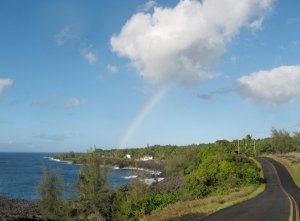
Rainbow over Kehena Beach
A five minute drive past Kehena will bring you to the intersection of Rt. 130 to Pahoa and is an excellent spot to pull off the road and snap a photo of the “laze” (lava haze or steam plume).

Laze Plume Rising from Ocean Entry at Kalapana
Travel on to the end of the road, and you’ll find the Kalapana Cafe, Uncle Roberts Kava Bar and the path to “Coconut Beach”, the newest black sand beach on Earth!
Now that we’ve come to the end of the road, let’s go back to Opihikao and travel the other half of Red Road toward Kapoho (as if you’ve not had enough to fill your senses already!).
As you travel east from Opihikao you’ll immediately go down a “dip” in the road. This is one of my favorite spots. Lined with impatiens flowers which grow like weeds on the Big Island and canopied with various trees, it’s an idyllic setting with residential driveways on both sides. Sunlight flickers through the trees and cool breezes fill your senses.
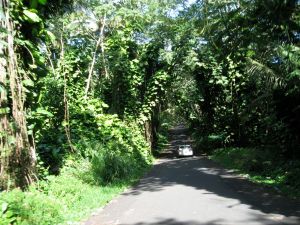
Dip in the road at Opihikao
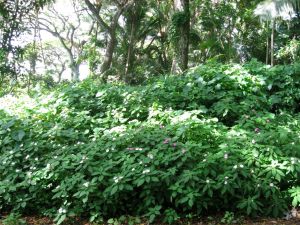
Impatiens
Typically when there are dips and hills in the roads throughout the Puna District it means that there are lava tubes underneath the hills. Lava tubes are formed when lava from the Kilauea volcano flows and hardens over itself forming a tube. When this happens, the lava (pahoehoe) flows faster inside the tube. Once the lava flow shifts, the tube remains. My understanding is that when constructing the roads the lava tubes are preserved rather than flattened which makes for fun drives in certain areas of Puna. Hold on to your stomach!
Continuing to the east on Red Road, you will find yourself passing Mackenzie Park on the right and the Malama Ki Forest Reserve on the left. Speaking of lava tubes, there are two lava tube collapse pits in Mackenzie Park which provide an excellent view of the unique geography of this area. Due to the nature of lava rock and tree roots, without a 4-wheel drive it’s nearly impossible to enter Mackenzie Park very far but well worth a “park and walk” experience. 60 feet out from the cliffs, the ocean drops to 3,000 feet in depth. Whales swim by very close to shore here and can usually be seen in this area from January to April.
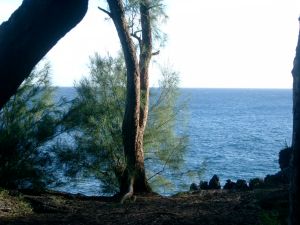
View from cliffs at Mackenzie Park
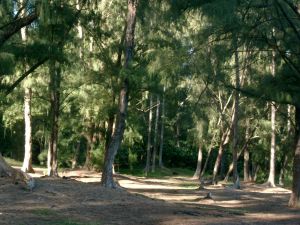
Needle covered lava rock and Ironwood trees at Mackenzie Park
As they say, hahai no ka ua I ka ulula’au (rains always follow the forest) and thankfully the state of Hawai’i is very conscious about preserving it or it would likely be clear cut for development. The forest reserve system in Hawaii is both a public and private partnership to protect and enhance forested lands. The effect of the Malama Ki reserve is quite apparent when driving through this area as you can feel the temperature cool slightly making for a lovely breeze even on hot, sunny days.
Just around the next few bends in the road you will come to an intersection*. Turn right and you will arrive at Isaac Hale (pronounced ha-lay) Beach Park. Located on the eastern edge of Pohoiki Bay (pronounced po-ho-ee-kee), you’ll find surfers catching waves, a boat ramp, swimming, picnic tables, barbeques and lots of local fun. Newly renovated, this park features large parking areas, restroom facilities (ok, porto-potties called a “lua” in Hawai’i which I have to say are generally the cleanest I’ve seen).
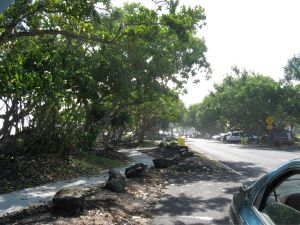
Isaac Hale Beach Park
Continue traveling east from Isaac Hale and you will arrive at Ahalanui Park or warm ponds as it is called locally. The pond located within this park is truly amazing. Geothermally heated brackish water mixes with ocean water creating a perfect temperature in which to swim year ’round.
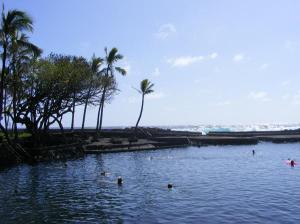
Ahalanui Park "Warm Ponds"
Are we having fun yet? By the way, you can bring a packed lunch or buy a “dog”, a bag of chips and a soda from a local vendor.
Back in the car, and heading east again we finally get to see what Red Road looked like back in the day. The straight strip cutting through the a’a lava flow of the 1960’s that covered Kapoho is actually still red.

Red Road toward Kapoho
When conditions are just right, be sure to look to your left for a surprising view of Mauna Kea in the distance.
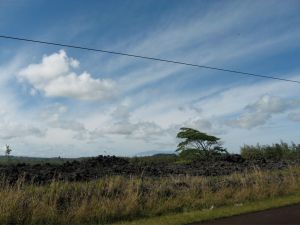
View of Mauna Kea in the distance off Red Road near Kapoho
Are we there yet? Are we there yet? Almost! Turn right onto Kapoho Kai Road and you will enter the marine protected tide pools area. I’ve written a previous piece on the tide pools but must include it in our drive on Red Road. The calm, warm waters are perfect for snorkeling or simply floating on your back and staring at blue sky. The “pools” are at various depths so there is one for everyone in the family. Be sure to bring rubber soled reef shoes to protect your feet entering and exiting the lava rock pools.
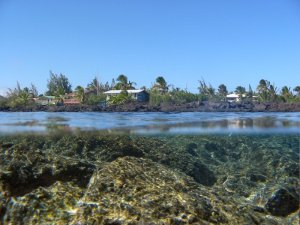
Wai 'Opae marine protected tide pools
And, last but not least is the gated community of Kapoho Beach Lots and Champagne Ponds. If you don’t know someone who lives in this community, you’ll need to go down to the 3 way stop on Red Road to what’s referred to as “four corners” and turn right. This will take you to the Cape Kumukahi Lighthouse and there is a gravel road that winds around to the Champagne Ponds area. The lighthouse survived the lava flow of 1960 and still remains today. It’s light can be seen flashing from the hillsides of Hilo. Cape Kumukahi is of spiritual importance to native Hawaiians and is the easternmost point of Hawai’i’s Big Island where the morning sun’s first rays shine.
In this small inlet area, sea turtles play and heat bubbles up from underneath the ocean floor, hence the name “champagne ponds”. There is great snorkeling here in calm inlet waters.
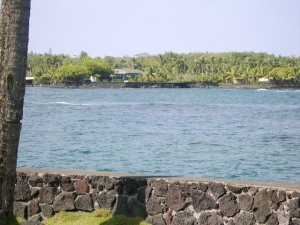
Photo of the entrance to Champagne Ponds taken from across the ocean at Dragon's Point
There is much to see and do on an excursion along this scenic coastal route and I hope you have enjoyed our Red Road drive. It’s well worth the time to visit this area. While I’ve covered the highlights of this drive, there are many opportunities along the way to experience the beauty and wonder of nature in a way that is personal to you. Whether watching a mother sea turtle teach her baby how to dive for food, or marveling at the ability to safely observe the huge steam plume created from lava flowing into the sea, Red Road is not to be missed.
Aloha Tips for Driving Red Road:
There is so much to see it is recommended that you pull over in various spots to get out and view. Red Road is very narrow in spots so take care to stay on your side of the road. The Aloha way when driving is to pull over and let people pass if you are going slow to see the sights. There are a few blind spots and several blind driveways so take care to watch for oncoming traffic and residents pulling out from driveways.
*There is a new by-pass at this intersection. If you go straight you will miss Isaac Hale Beach Park.
Opihikao Map (1)
http://24timezones.com/mapa/usa/hi_hawaii/opihikao.htm
Malama Ki Forest Reserve
http://www.state.hi.us/dlnr/dofaw/frs/page10.htm

[…] steps onto the fields of elysium May 9, 2009the yellow fields of england May 4, 2009 The Daily FlowDriving Red Road May 22, 2009Kapoho Tide Pools May 16, 2009Red Road Blocked by Police Today May 10, 2009Response […]
By: Driving Red Road « From Big Island (FBI) on May 22, 2009
at 11:31 am
I love driving along Red Road. Such a unique part of our beautiful island. We usually start from the Kalapana side and drive toward Kapoho.
I like to stop along the way in several places and usually pack a picnic lunch to eat either at McKenzie Park or another area to which I don’t know the name but where you can find several petroglyphs carved on the rocks.
By: foodiesleuth on May 24, 2009
at 8:15 am